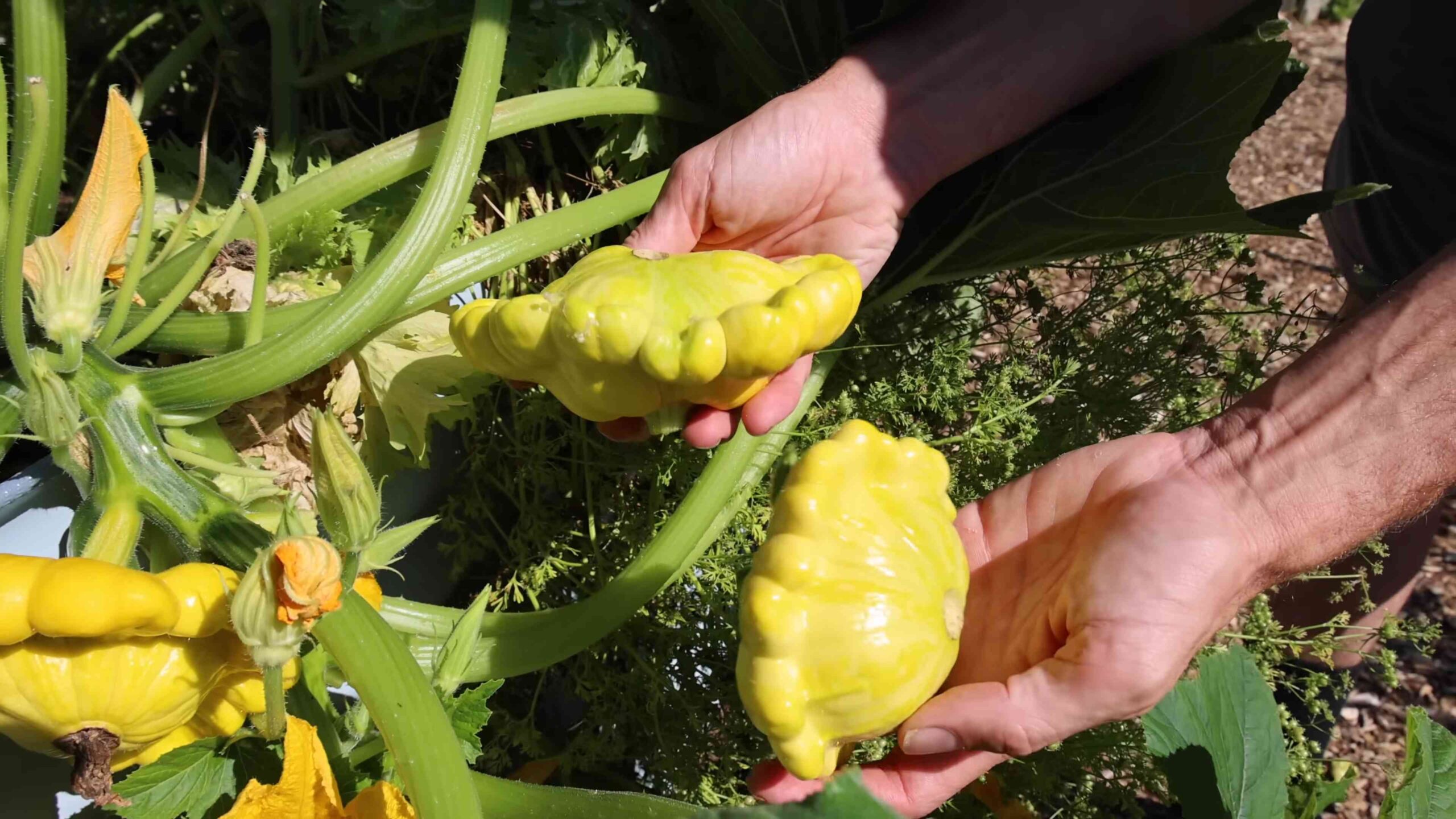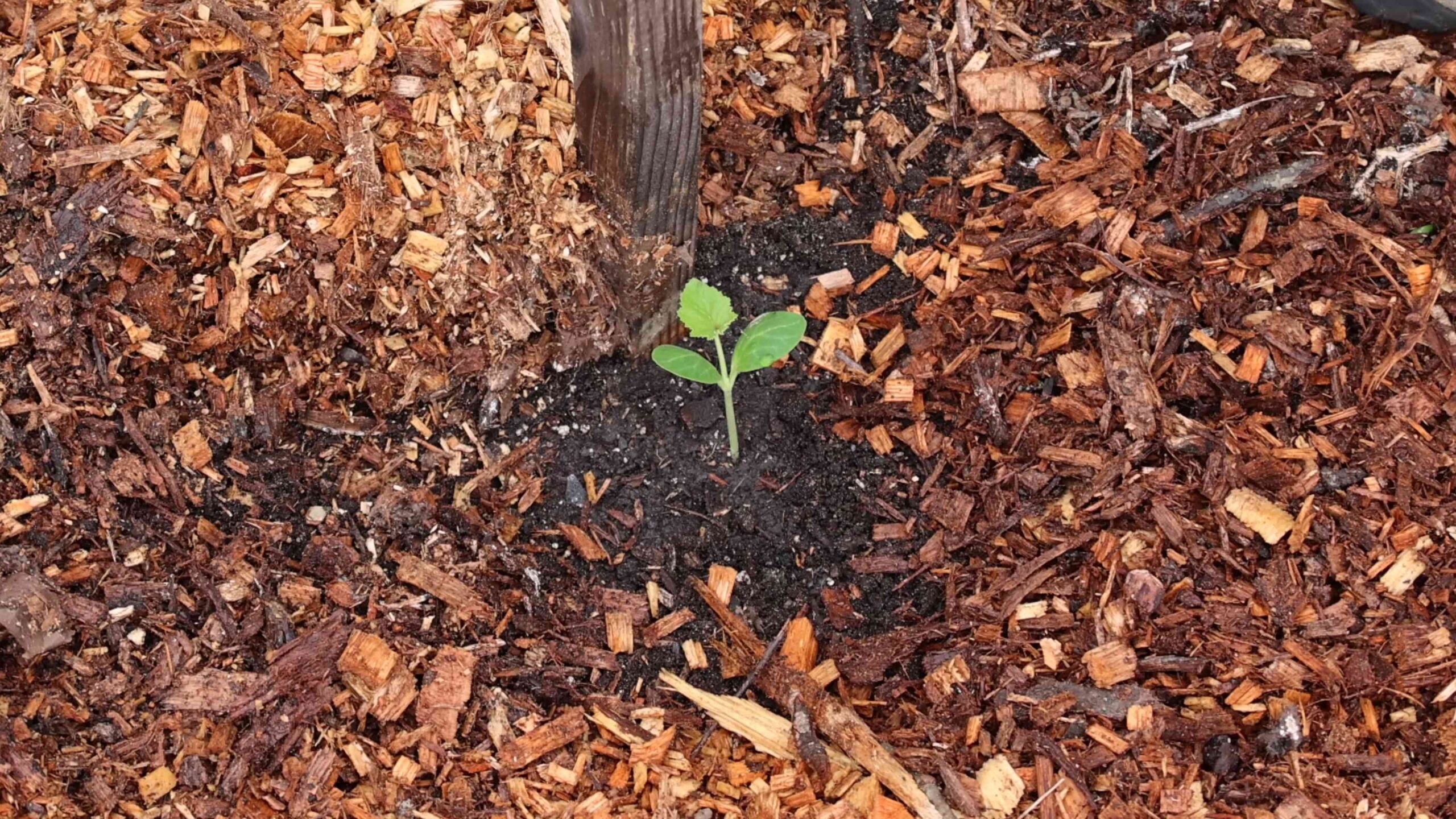Vertical squash gardening: Ever dreamed of a lush, overflowing garden but thought you didn’t have the space? I get it! We’ve all seen those picture-perfect gardens and sighed, thinking it’s just not possible in our small yards or balconies. But what if I told you there’s a way to grow delicious, sprawling squash even if you’re short on ground?
For centuries, cultures around the world have cleverly utilized vertical space for growing food. Think of the ancient Hanging Gardens of Babylon, or even the simple bean trellises used by indigenous communities. This isn’t just a modern trend; it’s a time-tested technique! And now, it’s your turn to tap into that wisdom.
Squash, with its vining nature, is actually perfectly suited for vertical growth. By training your squash plants to climb, you’ll not only save precious ground space, but you’ll also improve air circulation, reduce the risk of diseases, and even make harvesting easier. Plus, let’s be honest, a wall of vibrant green squash is a stunning visual addition to any home.
This DIY guide is packed with simple, effective tricks and hacks to help you master vertical squash gardening. I’ll walk you through everything from choosing the right varieties to building your own supports, ensuring you have a bountiful harvest, no matter how small your space. So, grab your gardening gloves, and let’s get growing!

DIY Vertical Squash Gardening: Grow Up, Not Out!
Hey there, fellow gardeners! Are you dreaming of a bountiful squash harvest but short on space? Well, I’ve got the perfect solution for you: vertical squash gardening! It’s a fantastic way to maximize your yield, keep those sprawling vines in check, and add a touch of visual interest to your garden. Trust me, once you try it, you’ll be hooked!
This guide will walk you through everything you need to know to create your own thriving vertical squash garden. We’ll cover choosing the right squash varieties, building a sturdy support structure, planting and training your vines, and providing the care they need to flourish. Let’s get started!
Choosing the Right Squash Variety
Not all squash varieties are created equal when it comes to vertical gardening. You’ll want to choose types that are relatively compact and produce smaller fruits. Here are a few of my favorites:
* Zucchini: These are prolific producers and relatively easy to train. Look for bush varieties for even more compact growth.
* Yellow Squash: Similar to zucchini, yellow squash is a great option for vertical gardening.
* Patty Pan Squash: These cute, saucer-shaped squash are also well-suited for growing upwards.
* Delicata Squash: This winter squash has a manageable size and delicious flavor.
* Spaghetti Squash: While the fruits can be a bit larger, spaghetti squash can still be grown vertically with proper support.
* Smaller Pumpkins: Varieties like ‘Jack Be Little’ or ‘Baby Boo’ are perfect for adding a festive touch to your vertical garden.
Things to Consider:
* Fruit Size: Larger squash varieties, like some pumpkins or butternut squash, can become too heavy for vertical supports. If you do choose a larger variety, you’ll need to provide extra support for the fruits as they develop.
* Vine Length: Look for varieties that are described as “bush” or “semi-bush” rather than those that are known for extremely long, sprawling vines.
* Disease Resistance: Choose varieties that are resistant to common squash diseases like powdery mildew.
Building Your Vertical Support Structure
The key to successful vertical squash gardening is a strong and reliable support structure. There are several options you can choose from, depending on your space, budget, and aesthetic preferences. Here are a few ideas:
* Trellises: A sturdy trellis is a classic choice for vertical gardening. You can purchase a pre-made trellis or build your own using wood, bamboo, or metal.
* Arches: An archway trellis adds a dramatic touch to your garden and provides ample support for climbing vines.
* Cattle Panels: These are large, sturdy metal panels that are commonly used for livestock fencing. They make excellent supports for squash and other vining plants.
* DIY Structures: Get creative and build your own unique support structure using recycled materials like pallets, old ladders, or even repurposed furniture.
Important Considerations for Your Support Structure:
* Strength: Your support structure needs to be strong enough to support the weight of the mature squash vines and fruits.
* Stability: Make sure your structure is securely anchored in the ground to prevent it from tipping over in strong winds.
* Accessibility: Choose a design that allows you to easily access the plants for watering, fertilizing, and harvesting.
* Material: Consider the durability of the material you choose. Wood will eventually rot, while metal will last longer but may rust.
Step-by-Step Guide to Building a Simple Trellis
For this guide, I’ll show you how to build a simple and sturdy wooden trellis. This is a great option for beginners and can be easily customized to fit your space.
Materials You’ll Need:
* Four 8-foot long 2×4 lumber pieces (for the frame)
* One 8-foot long 1×2 lumber piece (for the horizontal supports)
* Wood screws (2-inch and 3-inch)
* Wood glue
* Exterior wood stain or paint (optional)
* Measuring tape
* Pencil
* Saw (circular saw or hand saw)
* Drill with screwdriver bits
* Safety glasses
* Gloves
Instructions:
1. Cut the Lumber:
* Cut two of the 2x4s into 6-foot lengths. These will be the vertical posts of your trellis.
* Cut the remaining two 2x4s into 4-foot lengths. These will be the top and bottom horizontal supports.
* Cut the 1×2 into several pieces, each about 1 foot long. The number of pieces will depend on how closely spaced you want your horizontal supports. I usually go for about 6-8 pieces.
2. Assemble the Frame:
* Apply wood glue to the ends of the 4-foot 2x4s.
* Attach the 4-foot 2x4s to the top and bottom of the 6-foot 2x4s, forming a rectangular frame. Make sure the corners are square.
* Secure the frame with 3-inch wood screws. Drill pilot holes first to prevent the wood from splitting.
3. Add Horizontal Supports:
* Decide on the spacing for your horizontal supports. I usually space them about 1 foot apart.
* Mark the locations for the supports on the inside of the frame.
* Apply wood glue to the ends of the 1×2 pieces.
* Attach the 1×2 pieces to the frame at the marked locations, using 2-inch wood screws. Again, drill pilot holes first.
4. Finishing Touches (Optional):
* Sand down any rough edges or splinters.
* Apply exterior wood stain or paint to protect the trellis from the elements and give it a more finished look. Let it dry completely before using.
5. Install the Trellis:
* Choose a sunny location in your garden for your trellis.
* Dig two holes, about 1 foot deep, where you want to place the vertical posts of the trellis.
* Place the trellis in the holes and backfill with soil.
* Tamp down the soil around the base of the trellis to secure it in place. You can also use stakes to provide extra support.
Planting and Training Your Squash Vines
Now that you have your support structure in place, it’s time to plant your squash!
1. Prepare the Soil:
* Squash plants need rich, well-drained soil. Amend your soil with compost or other organic matter to improve its fertility and drainage.
* Make sure the soil is loose and free of rocks or debris.
2. Plant the Seeds or Seedlings:
* You can start squash seeds indoors 2-3 weeks before the last frost, or direct sow them in the garden after the danger of frost has passed.
* If starting seeds indoors, transplant the seedlings to the garden when they have 2-3 true leaves.
* Plant the seeds or seedlings at the base of your trellis, spacing them according to the variety’s recommendations. I usually plant 2-3 plants per trellis.
3. Water Thoroughly:
* Water the newly planted seeds or seedlings thoroughly to help them establish their roots.
4. Training the Vines:
* As the squash vines grow, you’ll need to train them to climb the trellis.
* Gently guide the vines towards the trellis and use soft plant ties or twine to secure them in place.
* Continue to train the vines as they grow, encouraging them to spread out evenly across the trellis.
* Remove any unwanted side shoots or suckers to encourage the plant to focus its energy on producing fruits.
Caring for Your Vertical Squash Garden
Once your squash plants are established, they’ll need regular care to thrive.
1. Watering:
* Squash plants need consistent moisture, especially during hot, dry weather.
* Water deeply and regularly, aiming to keep the soil consistently moist but not waterlogged.
* Water at the base of the plants to avoid wetting the foliage, which can lead to fungal diseases.
2. Fertilizing:
* Squash plants are heavy feeders and benefit from regular fertilization.
* Apply a balanced fertilizer every 2-3 weeks, following the package instructions.
* You can also side-dress the plants with compost or other organic matter.
3. Pest and Disease Control:
* Keep an eye out for common squash pests like squash bugs, squash vine borers, and aphids.
* Use organic pest control methods like hand-picking, insecticidal soap, or neem oil to control pests.
* Prevent fungal diseases by providing good

Conclusion
So, there you have it! Transforming your squash patch into a vertical garden isn’t just a trendy gardening fad; it’s a game-changer for maximizing space, improving plant health, and ultimately, yielding a more bountiful harvest. We’ve explored the myriad benefits, from enhanced air circulation that combats common squash diseases like powdery mildew to the sheer joy of watching your squash climb and thrive in a way you never thought possible.
This isn’t just about aesthetics, although the visual appeal of a lush, green wall of squash is undeniable. It’s about making the most of your resources, whether you’re working with a small balcony, a compact urban garden, or simply want to optimize your existing garden space. By embracing vertical squash gardening, you’re actively creating a more efficient and productive growing environment.
But the beauty of this method lies in its adaptability. Feel free to experiment with different support structures. While we’ve discussed trellises and netting, consider repurposing old ladders, creating A-frame structures, or even using sturdy tomato cages for smaller squash varieties. The key is to provide adequate support as your plants grow and their fruits develop.
And don’t limit yourself to just one type of squash! While vining varieties like butternut, spaghetti, and delicata are particularly well-suited for vertical growing, you can also train bush varieties with careful pruning and support. Consider companion planting at the base of your vertical structure. Marigolds, nasturtiums, and basil can help deter pests and attract beneficial insects, creating a thriving ecosystem around your squash.
Remember to adjust your watering and fertilizing schedule to accommodate the increased demands of vertical growth. Regular monitoring is crucial to ensure your plants are receiving the nutrients and moisture they need to flourish. And don’t be afraid to get creative with your pruning techniques. Removing excess foliage can improve air circulation and direct the plant’s energy towards fruit production.
Ultimately, the success of your vertical squash garden hinges on your willingness to experiment and adapt. Every garden is unique, and what works for one gardener may not work for another. So, embrace the learning process, observe your plants closely, and don’t be afraid to make adjustments along the way.
We wholeheartedly encourage you to give this DIY trick a try. The rewards are well worth the effort. Imagine the satisfaction of harvesting plump, healthy squash from your own vertical garden, knowing that you’ve maximized your space and created a thriving ecosystem in the process.
And most importantly, we want to hear about your experiences! Share your photos, tips, and challenges with us. Let’s build a community of vertical squash gardeners who can learn from each other and inspire others to embrace this innovative growing method. Use the hashtag #VerticalSquashGarden on social media so we can all see your amazing creations. Happy gardening!
Frequently Asked Questions (FAQ)
What types of squash are best suited for vertical gardening?
The best types of squash for vertical gardening are vining varieties, as they naturally climb and spread. Excellent choices include:
* Butternut squash
* Spaghetti squash
* Delicata squash
* Acorn squash (smaller varieties)
* Some types of gourds
However, even bush varieties can be trained vertically with careful pruning and support. Smaller bush varieties are easier to manage in a vertical system.
What kind of support structure should I use for my vertical squash garden?
The ideal support structure depends on the size and weight of the squash variety you’re growing. Here are some options:
* **Trellises:** Sturdy wooden or metal trellises are a popular choice. Ensure the trellis is tall and strong enough to support the mature plants and their fruits.
* **Netting:** Heavy-duty netting, such as nylon or wire mesh, can be stretched between posts or attached to a frame. This is a good option for lighter squash varieties.
* **A-frame structures:** These provide excellent stability and can be easily constructed from wood or metal.
* **Tomato cages:** Large, sturdy tomato cages can be used for smaller squash varieties or to provide initial support for larger vines.
* **Repurposed materials:** Get creative! Old ladders, fences, or even sturdy branches can be repurposed into unique and functional support structures.
How do I train my squash vines to grow vertically?
Training squash vines involves gently guiding them up the support structure and securing them in place. Here’s how:
* **Start early:** Begin training the vines when they are young and pliable.
* **Use soft ties:** Use soft plant ties, twine, or strips of cloth to attach the vines to the support structure. Avoid using wire or anything that could damage the stems.
* **Space the ties:** Space the ties evenly along the vine to provide consistent support.
* **Guide the vines:** Gently guide the vines in the direction you want them to grow.
* **Prune as needed:** Prune away any unwanted side shoots or leaves to encourage vertical growth and improve air circulation.
How do I support the weight of the squash fruits as they grow?
As squash fruits develop, they can become quite heavy and may need additional support to prevent them from breaking off the vine. Here are some methods:
* **Slings:** Create slings from netting, fabric, or pantyhose to support the individual fruits. Attach the slings to the support structure.
* **Platforms:** Build small platforms from wood or wire mesh to support the fruits from below.
* **Reinforce the support structure:** Ensure your support structure is strong enough to handle the weight of the mature plants and their fruits.
How often should I water and fertilize my vertical squash garden?
Vertical gardens tend to dry out more quickly than traditional gardens, so regular watering is essential. Water deeply and frequently, especially during hot, dry weather. Check the soil moisture regularly and water when the top inch feels dry.
Fertilize your squash plants regularly with a balanced fertilizer. Follow the instructions on the fertilizer package. You can also supplement with compost tea or other organic fertilizers.
What are some common pests and diseases that affect squash plants, and how can I prevent them in a vertical garden?
Common pests and diseases that affect squash plants include:
* **Squash vine borers:** These pests can be prevented by using row covers or wrapping the base of the stems with aluminum foil.
* **Squash bugs:** Handpick squash bugs and their eggs from the plants.
* **Powdery mildew:** This fungal disease can be prevented by ensuring good air circulation and avoiding overhead watering.
* **Aphids:** Control aphids with insecticidal soap or neem oil.
Vertical gardening can help prevent some of these problems by improving air circulation and making it easier to spot and remove pests.
Can I grow squash vertically in containers?
Yes, you can grow squash vertically in containers, but you’ll need to choose a large container (at least 20 gallons) and use a well-draining potting mix. Ensure the container is sturdy enough to support the weight of the mature plant and its fruits. Provide a strong support structure and water and fertilize regularly.
What are some companion plants that I can grow with my vertical squash?
Companion planting can help deter pests, attract beneficial insects, and improve the overall health of your vertical squash garden. Good companion plants for squash include:
* Marigolds
* Nasturtiums
* Basil
* Oregano
* Dill
* Radishes
* Beans
* Corn
How much sunlight do squash plants need?
Squash plants need at least 6-8 hours of sunlight per day to thrive. Choose a location for your vertical squash garden that receives plenty of sunlight.
How do I know when my squash is ripe and ready to harvest?
The ripeness of squash varies depending on the variety. Generally, squash is ripe when the skin is hard and dull, and the stem is dry and tough. You can also tap the squash; a ripe squash will sound hollow. Harvest your squash carefully to avoid damaging the plant.





Leave a Comment